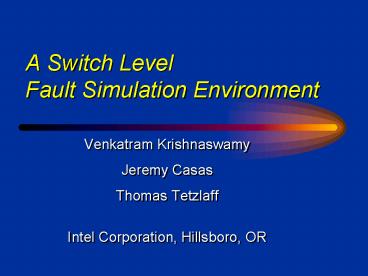A Switch Level Fault Simulation Environment - PowerPoint PPT Presentation
1 / 21
Title:
A Switch Level Fault Simulation Environment
Description:
Accurate fault location for defect based test ... ternary logic value model {0,1,X} transistor strength modeling. capacitance modeling ... – PowerPoint PPT presentation
Number of Views:72
Avg rating:3.0/5.0
Title: A Switch Level Fault Simulation Environment
1
A Switch LevelFault Simulation Environment
- Venkatram Krishnaswamy
- Jeremy Casas
- Thomas Tetzlaff
- Intel Corporation, Hillsboro, OR
2
Overview
- Need for switch level capability
- Fault injection techniques
- Fault Simulation Algorithms and Performance
- Mixed Level Fault Simulation
- Conclude
3
Motivation for Switch Level
- Cost of creating gate level database
- remodeling effort, library maintenance
- Accurate fault location for defect based test
- Piggy back on other design activities for tuned
circuit database - Formal Verification
- Dynamic Verification
- Challenge is to make it feasible to manipulate
more information at reasonable cost
4
Related Work
- Gate level fault simulation
- Concurrent algorithms (Ulrich et al)
- Differential algorithm (Cheng et al)
- PROOFS (Niermann et al)
- Switch level fault simulation
- Switch level concurrent (Schuster et al)
- Switch level PROOFS (Vandris et al)
5
Stuck Fault Injection
6
Transition Fault Injection
7
Transition Fault Injection
8
Transition Fault Injection
9
Fault Injection Strategy
- Flexibility
- stuck fault model
- transition faults
- bridging faults
- Efficiency
- minimize simulation overhead
10
Fault Simulation Overview
- Perform good machine logic simulation for each
vector - save state of the machine
- Faults are injected
- initial states of faulty machines are restored
- Faulty machines are simulated for the given
vector - final states of machines analyzed
- Differences in state between good and faulty
machines need to be computed and stored for use
with following vector
11
Fault Simulation Algorithm Specs
- Capable of simulating complex circuit styles
- domino, self timed precharge, freq.
Multiplication - Minimize faulty machine simulation overhead
- Minimize state manipulation overhead
- Exploit word level parallelism
12
Problems posed by switch level fault simulation
- Massive number of sequential nodes
- recirculating feedback
- capacitive nodes
- Support of certain circuit styles is costly as
they require unit delay simulation algorithm - precharge-discharge circuits
- self timed precharge
- clock frequency multiplication
13
Underlying logic simulation models
- Circuit Model (ref COSMOS - Bryant et al)
- ternary logic value model 0,1,X
- transistor strength modeling
- capacitance modeling
- Delay Model
- unit delay model
- devices can be selected to be zero delay
14
Unit Delay Fault Simulation Algorithm
- PROOFS style algorithm requires faulty machine
simulation after every unit step of logic
simulation - Overhead of faulty machine state manipulation
dominates runtime at switch level - Cheaper to completely relax good machine and
faulty machines separately - downside is recomputation of events in good
machine
15
Optimization of State Manipulation
- Aim is to minimize value copying to and from
simulation data structures - State differences between passes are maintained
with respect to the last simulated pass. - First fault pass differences computed w.r.t good
machine - Second fault pass differences computed w.r.t
first fault pass - Complicates fault dropping and reordering
16
Simulator Performance Analysis
- Figure of merit is Fault Hertz
- computed as (faults cycles)/cpu seconds
- Factors contributing to high Fault Hz numbers
- fast underlying logic simulator
- efficient state manipulation
- Good indication of algorithm scalability
17
Performance of Fault Simulator
- Performance improves with increasing number of
faults - improvement tails off after 400-800 faults for
unit (100,000 transistors) - Full chip Pentium II runs at about 26 fault
Hertz - Memory performance is good given large number of
differential states
18
Optimizing Fault Simulation Algorithm
- Attempt to minimize fault passes
- use concept of active modules
- only fault passes with active modules are
simulated - Dynamic regrouping of fault passes
- faulty machines are periodically regrouped
- idea is to eliminate faulty passes with one or
two active machines. - Performance improvement ranges from factor of 2
to 4 - PentiumII now simulates at 40 fault Hertz
19
Mixed Level Fault Simulation
- Seed faults in blocks modeled at switch level
- Propagate fault effects to POs using RTL model
- leverage performance of RTL simulation
- Communication between simulators through APIs
- RTL simulator runs as master
20
Mixed Level Simulation Issues
- Determination of signal strengths
- drive strength information is compiled in model
- insert structure to determine strength to
communicate across simulation APIs - Resolution of multiply driven nodes
- drivers may reside across switch level and RTL
- Performance better than commercialgate level
simulator in mixed level environment running
PentiumPro - Fault Hz ranges between 45 and 200 Fault Hertz
21
Conclusions
- Advantages of using switch level model
- Presented techniques for handling problems posed
by switch level fault simulation - efficient state manipulation
- unit delay tradeoffs for precharge-discharge
circuits - Simulation speed is not lost through the use of
mixed level simulation































